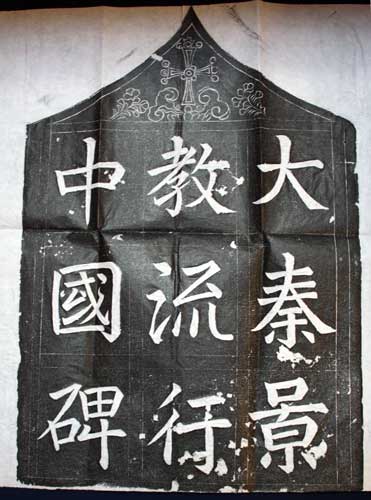Nestorian Tablet(ink rubbing)

Nestorian Tablet, Top, (ink rubbing)
Eulogizing the Propagation of the Illustrious Religion in China, with a Preface,
composed by a priest of the Syriac Church, 781 A.D.
20th century rubbing
GTU Rare Book Collection
This is a rubbing of the top piece of the Nestorian Monument. The discovery of this stele, indicating a Christian presence in medieval China, led to a reappraisal of China's history by the West. Uncovered around 1625, the slab then stood for centuries on the grounds of a Buddhist monastery, until the monument was moved to its current place in the Peilin or "Forest of Tablets" in Sian-fu.
On the actual limestone monument, which is nine feet by three and a half feet by one foot thick, are two dragons on either side at the top. The large letters under the Nestorian cross provide the title. Below, the script describes the doctrine of the faith, the history of how the Nestorian monks arrived, and how Chinese officials approved of the new religion as having "excellent principles." The inscription concludes with a poem, praising the religion and the Tang dynasty, and then indicates the date and scribe. The sides of the tablet are also inscribed, listing names from the sect's 150 years in China. The Chinese characters are interspersed with Syrian script, which is used for non-Chinese proper names.
The Nestorian sect of Christians flourished in Syria in the sixth century and sent missionaries widely over Asia. Centuries later, with the advent of Islam along with many other changes, contact was broken with the mission in China. Later travelers, including Marco Polo and then Catholic missionaries in later centuries, recorded meeting Christians in China, where a few inhabitants still practiced a form of the Nestorian faith.
Finding the monument, with the distinctive cross, led to many complicated discussions in the 17th through the 19th century in the West, until its authenticity was convincingly confirmed by British Sinologist Alexander Wylie (1815-1887). By the turn of the century, to Westerners the Nestorian Monument was almost as famous as the Great Wall of China.
The library has two large copies of the main text: one is transcribed in a scroll format; the other is an actual rubbing of similar quality to this piece, in several different pieces. These are sold at the gift shop at the Forest of Tablets. Along with numerous rubbings of the tablet, an exact stone replica was carved and taken to the West, ending up at the Vatican. Plaster copies were made of this replica and distributed to different parts of the world, including Yale.
Sources for this information (and for more extensive discussion): Michael Keevak, The story of a stele : China's Nestorian Monument and its reception in the West, 1625-1916 (2008); and Li Tang, A study of the history of Nestorian Christianity in China and its literature in Chinese : together with a new English translation of the Dunhuang Nestorian documents.
About Us | Contact Us
©2012 Graduate Theological Union Library